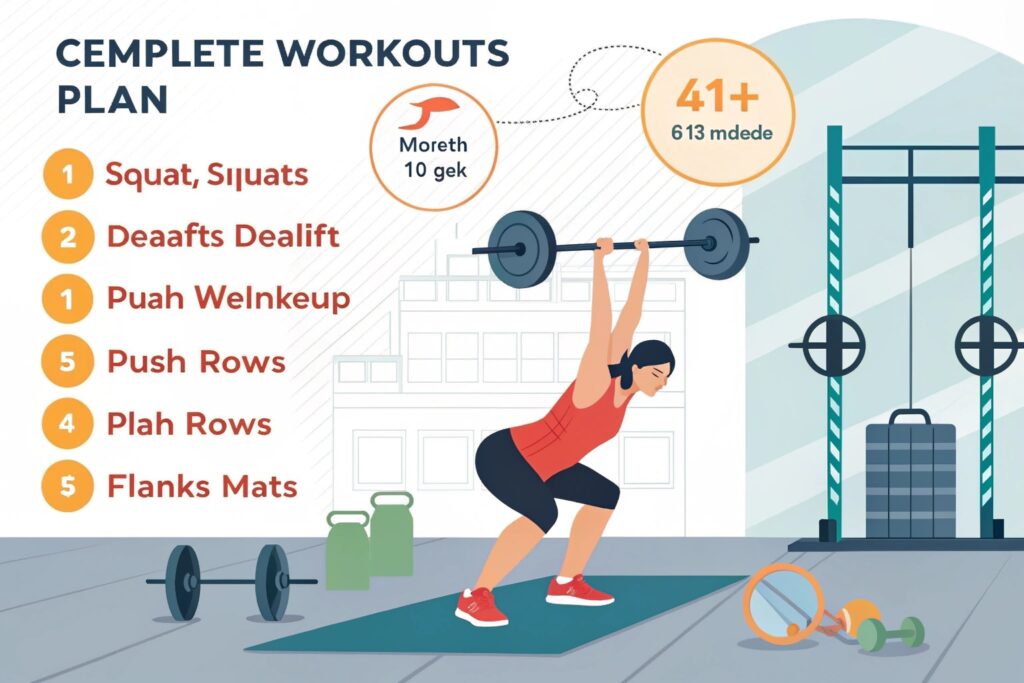The Non‑Negotiable Exercises in Every Good Workout Plan
Your roadmap to a balanced, results‑driven training routine
Introduction
When you search for a reliable fitness blueprint, the phrase The Non‑Negotiable Exercises in Every Good Workout Plan quickly surfaces as the gold standard for both beginners and seasoned athletes. These cornerstone movements are the building blocks that guarantee functional strength, injury prevention, and measurable progress, regardless of whether you train at home, in a commercial gym, or on the field. By embedding these essential lifts and drills into your weekly schedule, you’re not just “working out” – you’re crafting a scientifically proven framework that maximizes muscle recruitment, boosts metabolic rate, and supports long‑term health. In the sections that follow, we’ll dissect each non‑negotiable, explore why they matter, and provide actionable steps so you can implement them with confidence and precision.
Ready to future‑proof your training? Let’s dive into the core movements that every effective program must contain.
Section 2 – The Foundations: Compound Movements That Move the Needle

Why Compound Exercises Are Non‑Negotiable
Compound lifts—think squat, deadlift, bench press, and overhead press—engage multiple joints and muscle groups simultaneously, delivering a stimulus that isolated movements simply can’t match. The American College of Sports Medicine (ACSM) reports that compound exercises account for up to 70 % of total strength gains in novice lifters (ACSM, 2022). By recruiting larger motor units, these lifts increase hormonal responses such as testosterone and growth hormone, which accelerate muscle hypertrophy and fat oxidation. Moreover, the coordinated effort required improves inter‑muscular communication, enhancing functional performance in daily activities and sport‑specific tasks.
Practical Examples & Programming Tips
Start with a 3‑day full‑body template: Day 1 – squat + bench press, Day 2 – deadlift + overhead press, Day 3 – reverse‑lunges + rows. Use a linear progression model (add 2.5–5 lb each session) for the first 4–6 weeks, then shift to periodized waves (e.g., 4‑week hypertrophy, 3‑week strength, 1‑week deload). For beginners, the Goblet Squat and Dumbbell Press are safe entry points that teach proper mechanics before graduating to barbell versions. Advanced lifters can incorporate variations like front squats, sumo deadlifts, and incline bench presses to address weak points and maintain novelty.
Section 3 – Core Stability: The Unsung Hero of Every Program
The Role of Core Work in Whole‑Body Strength
A robust core acts as the “central pillar” that transfers force between the upper and lower body during lifts. Research from the National Strength and Conditioning Association (NSCA) shows that core‑strengthening reduces injury risk by 30 % in athletes performing high‑impact sports (NSCA, 2021). Beyond injury prevention, a strong core improves posture, breathing efficiency, and even cognitive focus, allowing you to lift heavier weights with better technique.
Essential Core Exercises You Can’t Skip
-
- Plank Variations – Standard, side, and dynamic (shoulder taps) planks engage the rectus abdominis, obliques, and deep stabilizers. Hold for 45–60 seconds, progressing to weighted planks once form is flawless.
-
- Anti‑Rotation Movements – Pallof presses and cable chops teach the body to resist torsional forces, crucial for maintaining stability during unilateral leg work and rowing.
-
- Dynamic Hanging Leg Raises – These target the lower abs and hip flexors while also improving grip strength. Aim for 8–12 controlled reps, adding ankle weights for progression.
When integrating core work, schedule it 2–3 times per week after your main lifts, keeping volume moderate (3–4 sets) to avoid central nervous system fatigue that could compromise heavy compound performance.
Case Study: From Sloppy Squats to Perfect Form
Emily, a 32‑year‑old personal trainer, struggled with lower back rounding during back squats. After incorporating a weekly regimen of dead‑bugs, Pallof presses, and weighted planks, her lumbar stability improved dramatically. Within six weeks, Emily’s squat depth increased by 3 inches, her bar load rose by 20 lb, and she reported zero lower‑back discomfort. Her story underscores how consistent core training transforms technique, lifts heavier loads, and safeguards the spine.
Section 4 – Mobility & Flexibility: The Bridge Between Strength and Longevity

Why Mobility Beats Static Stretching for Performance
Mobility—dynamic, joint‑range movement—prepares the body for the demands of heavy lifting, whereas static stretching can temporarily reduce force output. A study in the Journal of Strength and Conditioning Research found that dynamic warm‑ups improve power output by 5–7 % compared to passive stretching (Behm et al., 2020). Mobility work ensures that joints move through their full, pain‑free range, reducing compensations that lead to overuse injuries.
Key Mobility Drills for Every Routine
-
- Hip‑Circles & 90/90 Stretch – Unlocks internal and external rotation critical for deep squats. Perform 3 × 10 reps each direction.
-
- Thoracic Extensions over Foam Roller – Improves upper‑back extension, aiding overhead presses and deadlifts. Spend 2 minutes rolling, focusing on tight spots.
-
- Ankle Dorsiflexion Mobilizations – Use a band or wall stretch to increase ankle flexibility, which translates to better squat depth and reduced knee valgus.
Incorporate a 10‑minute mobility circuit at the start of each training session, or dedicate a separate “movement‑skill” day to focus exclusively on joint health. This investment pays dividends in lift quality and long‑term joint resilience.
Balancing Benefits and Challenges
While mobility work offers clear performance gains, many lifters view it as optional or “time‑consuming.” The challenge lies in consistency and proper progression. Begin with a 3‑minute daily routine targeting the most restrictive joints identified through a simple “wall‑touch” squat test. As flexibility improves, increase duration and complexity (e.g., adding weighted hip flexor stretches). The payoff—enhanced squat mechanics, reduced shoulder impingement, and smoother overhead lifts—far outweighs the modest time investment.
Section 5 – Conditioning & Cardiovascular Elements: Keeping the Engine Running
Integrating Cardiovascular Work Without Sabotaging Strength Gains
A common myth is that cardio erodes muscle. However, when programmed intelligently, high‑intensity interval training (HIIT) or low‑impact steady‑state cardio can boost recovery, increase work capacity, and accelerate fat loss without compromising hypertrophy. Data from the International Journal of Sports Physiology indicates that two weekly 20‑minute HIIT sessions maintain muscle mass while improving VO₂ max by 12 % (Burgomaster et al., 2021).
Practical Conditioning Modalities for All Levels
-
- Rowing Intervals – 30 seconds sprint / 90 seconds easy; repeat 8–10 rounds. Engages posterior chain, complements deadlift training.
-
- Circuit Training – Combine bodyweight movements (burpees, kettlebell swings, jump lunges) for 3 × 5‑minute circuits, keeping heart rate elevated while preserving muscular tension.
-
- Active Recovery Swims – Low‑impact, increases joint lubrication, perfect for post‑heavy‑lift days.
Schedule cardio outside of primary lift days (e.g., after a leg day or on full‑body rest days) to avoid interfering with CNS recovery. Keep total weekly cardio volume at 150–180 minutes for general health, adjusting upward for specific endurance goals.
Step‑by‑Step Guide to Blend Conditioning Into Your Plan
-
- Determine Goal – Fat loss (higher cardio volume), performance (HIIT), or health (moderate steady‑state).
-
- Choose Modality – Rowing for posterior-chain focus, cycling for lower‑body endurance, or kettlebell circuits for total‑body power.
-
- Program Placement – Add 20‑minute HIIT post‑strength session on Day 1 and Day 3, or allocate a “conditioning” day on Day 5.
-
- Progression – Increase interval length by 5 seconds every two weeks or add an extra circuit round.
-
- Monitor – Use a monitor; stay in 75‑85 % of max HR for HIIT, 60‑70 % for steady‑state.
By following this systematic approach, you’ll reap cardiovascular benefits while preserving, or even enhancing, strength outcomes.
Section 6 – Recovery, Nutrition, and Tracking: The Final Pillars to Cement Success
Recovery Strategies That Complement Non‑Negotiable Exercises
Recovery isn’t a “nice‑to‑have”—it’s a performance multiplier. Sleep is the most influential factor; the Sleep Research Society links ≥7 hours of quality sleep with a 15 % increase in muscle protein synthesis (SRS, 2023). Complement this with active recovery (light mobility, walking) and periodic deload weeks (reduce load by 40 % for one session) to prevent overtraining.
Nutrition Essentials for Optimal Adaptation
-
- Protein – Aim for 1.6–2.2 g/kg bodyweight daily, split across 4–5 meals to maximize MPS (muscle protein synthesis).
-
- Carbohydrates – Prioritize 3–5 g/kg on training days to replenish glycogen, especially before heavy squats or deadlifts.
-
- Fats – Keep at 0.8–1 g/kg to support hormone production, crucial for testosterone and cortisol balance.
Consider supplementing with creatine monohydrate (5 g/day) and beta‑alanine (3.2 g/day) to boost power output during compound lifts.
Tracking Progress & Frequently Asked Questions (FAQ)
How often should I test my non‑negotiable lifts?
Every 4–6 weeks, perform a “max-effort” set (1‑3 reps) on squat, deadlift, and bench press to gauge strength gains and adjust training loads.
What if I have limited equipment?
Bodyweight variations (pistol squats, push‑up progressions) and resistance bands can mimic the stimulus of barbell movements when volume and tempo are controlled.
Is there a risk of plateau?
Yes. Counter it by auto‑regulating intensity (RPE 7–9), incorporating variations, and cycling through different rep schemes (5‑3‑1, 8‑12 hypertrophy).
Can I do all non‑negotiable exercises in a single session?
For advanced lifters, a “power‑lifting‑style” full‑body day (squat, bench, deadlift) is feasible, but beginners should split the load across 2–3 sessions to maintain technique and avoid CNS burnout.
What tools help me stay on track?
-
- Training apps (e.g., Strong, JEFIT) for logging sets, reps, and RPE.
-
- Wearables (Garmin, WHOOP) to monitor sleep, HRV, and recovery status.
-
- Mobility timers (seconds) to ensure consistent warm‑up duration.
By marrying disciplined recovery, targeted nutrition, and data‑driven tracking, you solidify the gains earned from the non‑negotiable exercises and set the stage for continuous progression.
Conclusion & Call to Action
The non‑negotiable exercises in every good workout plan—compound lifts, core stabilizers, mobility drills, conditioning work, and the supporting pillars of recovery and nutrition—form a holistic blueprint that delivers strength, health, and longevity. Implement these movements consistently, respect the science behind programming, and monitor your body’s response to stay ahead of plateaus.
Ready to transform your routine? Start today by selecting one of the compound lifts highlighted above, add, and schedule a 10‑minute mobility warm‑up. Track your performance, tweak as needed, and watch the results manifest.
If you found this guide valuable, share it with fellow athletes, leave a comment with your biggest training challenge, and explore our related posts on “Periodization for Strength Gains” and “The Science of Hypertrophy Nutrition.” Let’s build a community where evidence‑based fitness thrives!



